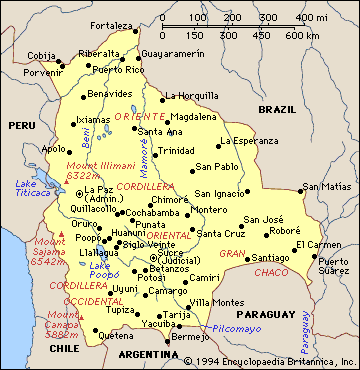
Geography
Location:
Central South America, between Brazil and Chile
Map
references: South America, Standard Time Zones of the
World
Area:
total area 1,098,580 sq km
land area 1,084,390 sq km
comparative area slightly less than three times the size
of Montana
Land
boundaries: total 6,743 km, Argentina 832 km, Brazil
3,400 km, Chile 861 km, Paraguay 750 km, Peru 900 km
Coastline:
0 km (landlocked)
Maritime
claims: none; landlocked
International
disputes: has wanted a sovereign corridor to the South
Pacific Ocean since the Atacama area was lost to Chile in
1884; dispute with Chile over Rio Lauca water rights
Climate:
varies with altitude; humid and tropical to cold and semiarid
Terrain: rugged Andes Mountains with a highland plateau
(Altiplano), hills, lowland plains of the Amazon Basin
Natural resources: tin, natural gas, petroleum, zinc,
tungsten, antimony, silver, iron ore, lead, gold, timber
Land use:
arable land 3%
permanent crops 0%
meadows and pastures 25%
forest and woodland 52%
other 20%
Irrigated land: 1,650 sq km (1989 est.)
Environment:
current issues deforestation contributing to loss of biodiversity;
overgrazing; soil erosion; desertification; industrial pollution
of water supplies used for drinking and irrigation
natural hazards flooding in the northeast (March to April)
international agreements party to - Endangered Species,
Nuclear Test Ban, Wetlands; signed, but not ratified - Biodiversity,
Climate Change, Environmental Modification, Hazardous Wastes,
Law of the Sea, Marine Dumping, Marine Life Conservation,
Tropical Timber
Note: landlocked; shares control of Lago Titicaca, world's
highest navigable lake (elevation 3,805 m), with Peru; cold,
thin air of high plateau is obstacle to efficient fuel combustion,
as well as to physical activity by those unaccustomed to
it from birth

People
Population: 7,719,445 (July 1994 est.)
Population growth rate: 2.28% (1994 est.)
Birth rate: 32.22 births/1,000 population (1994 est.)
Death rate: 8.37 deaths/1,000 population (1994 est.)
Net migration rate: -1.04 migrant(s)/1,000 population
(1994 est.)
Infant mortality rate: 73.7 deaths/1,000 live births
(1994 est.)
Life expectancy at birth:
total population 63.31 years
male 60.86 years
female 65.88 years (1994 est.)
Total fertility rate: 4.21 children born/woman (1994
est.)
Nationality:
noun Bolivian(s)
adjective Bolivian
Ethnic divisions: Quechua 30%, Aymara 25%, mestizo (mixed
European and Indian ancestry) 25%-30%, European 5%-15%
Religions: Roman Catholic 95%, Protestant (Evangelical
Methodist)
Languages: Spanish (official), Quechua (official), Aymara
(official)
Literacy: age 15 and over can read and write (1990 est.)
total population 78%
male 85%
female 71%
Labor force: 3.54 million
by occupation agriculture NA, services and utilities 20%,
manufacturing, mining and construction 7% (1993)

Government
Names:
conventional long form Republic of Bolivia
conventional short form Bolivia
local long form Republica de Bolivia
local short form Bolivia
Digraph: BL
Type: republic
Capital: La Paz (seat of government); Sucre (legal capital
and seat of judiciary)
Administrative divisions: 9 departments (departamentos,
singular - departamento); Chuquisaca, Cochabamba, Beni,
La Paz, Oruro, Pando, Potosi, Santa Cruz, Tarija
Independence: 6 August 1825 (from Spain)
National holiday: Independence Day, 6 August (1825)
Constitution: 2 February 1967
Legal system: based on Spanish law and Code Napoleon;
has not accepted compulsory ICJ jurisdiction
Suffrage: 18 years of age, universal and compulsory
(married); 21 years of age, universal and compulsory (single)
Executive branch:
chief of state and head of government President Gonzalo
SANCHEZ DE LOZADA Bustamente (since 6 August 1993); Vice
President Victor Hugo CARDENAS Conde (since 6 August 1993);
election last held 6 June 1993 (next to be held May 1997);
results - Gonzalo SANCHEZ DE LOZADA (MNR) 34%, Hugo BANZER
Suarez (ADN/MIR alliance) 20%, Carlos PALENQUE Aviles (CONDEPA)
14%, Max FERNANDEZ Rojas (UCS) 13%, Antonio ARANIBAR Quiroga
(MBL) 5%; no candidate received a majority of the popular
vote; Gonzalo SANCHEZ DE LOZADA won a congressional runoff
election on 4 August 1993 after forming a coalition with
Max FERNANDEZ and Antonio ARANIBAR
cabinet Cabinet; appointed by the president from panel proposed
by the Senate
Legislative branch: bicameral National Congress (Congreso
Nacional)
Chamber of Deputies (Camara de Diputados) elections last
held 6 June 1993 (next to be held May 1997); results - percent
of vote by party NA; seats - (130 total) MNR 52, UCS 20,
ADN 17, MIR 17, CONDEPA 13, MBL 7, ARBOL 1, ASD 1, EJE 1,
PDC 1
Chamber of Senators (Camara de Senadores) elections last
held 6 June 1993 (next to be held May 1997); results - percent
of vote by party NA; seats - (27 total) MNR 17, ADN 4, MIR
4, CONDEPA 1, UCS 1
Judicial branch: Supreme Court (Corte Suprema)
Political parties and leaders: Movement of the Revolutionary
Left (MIR), Jaime PAZ Zamora; Nationalist Democratic Action
(ADN), Jorge LANDIVAR; Nationalist Revolutionary Movement
(MNR), Gonzalo SANCHEZ DE LOZADA; Civic Solidarity Union
(UCS), Max FERNANDEZ Rojas; Conscience of the Fatherland
(CONDEPA), Carlos PALENQUE Aviles; Free Bolivia Movement
(MBL), Antonio ARANIBAR; Tupac Katari Revolutionary Liberation
Movement (MRTK-L), Victor Hugo CARDENAS Conde; Christian
Democrat Party (PDC), Jorge AGREDA
Member of: AG, ECLAC, FAO, GATT, G-11, G-77, IADB, IAEA,
IBRD, ICAO, IDA, IFAD, IFC, ILO, IMF, IMO, INTELSAT, INTERPOL,
IOC, IOM, ITU, LAES, LAIA, LORCS, NAM, OAS, OPANAL, PCA,
RG, UN, UNCTAD, UNESCO, UNIDO, UPU, WCL, WFTU, WHO, WIPO,
WMO, WTO
|